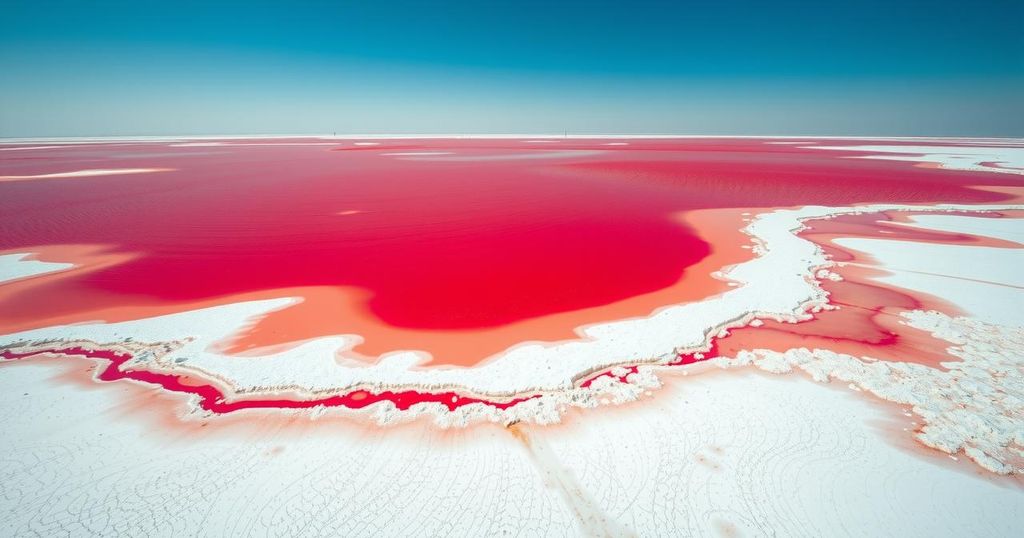The Strange Red Lake in Tanzania That Turns Animals to ‘Stone’

Lake Natron in Tanzania is a striking red lake known for transforming deceased animals into calcified statues due to its extreme alkalinity. The lake serves as a breeding ground for lesser flamingos that have adapted to its caustic waters. Local guidance is essential for safe visits, and conservation efforts aim to protect this unique ecosystem.
In northern Tanzania, a truly remarkable phenomenon resides: Lake Natron. This vibrant crimson lake is not just a stunning visual experience; it also poses serious risks, transforming unfortunate animals into calcified seraphs. Described as one of Africa’s oddities, Lake Natron showcases nature’s extremes, where death meets beauty in a unique and haunting display.
Lake Natron is a shallow, caustic lake radiating a striking red under the blazing African sunlight. The pigmentation is a product of microorganisms that have learned to survive in its highly alkaline water. Specifically, haloarchaea and cyanobacteria develop these vivid red pigments as a defense mechanism in such a harsh environment.
The lake’s pH can reach up to 10.5, which is almost as caustic as common ammonia. This high alkalinity makes it dangerous for most creatures, burning their skin and eyes if they venture too close. The environment is largely shaped by volcanic activity along the East African Rift System, where minerals flow in and hot springs bubble up from underneath.
During dry seasons, the surface area of Lake Natron shrinks significantly, intensifying its chemical makeup. The temperatures rise to terrifying levels—up to 140°F (60°C)—with an average depth of merely 1.6 feet (0.5 meters). This shallow nature allows for rapid evaporation and tremendous variations in water levels seasonally.
However, the most eerie aspect of Lake Natron is its ability to turn dead animals into stunning stone-like sculptures. When wildlife dies on or near its shores, the high sodium carbonate levels mummify the bodies, allowing them to become preserved as eerily beautiful statues. This process replaces the organic material with minerals, offering a macabre yet fascinating outcome.
The haunting captures by photographer Nick Brandt in 2013, showcased animals like birds and bats, appeared almost frozen in life thanks to the lake’s unique chemistry. These chilling images reveal how the environment can preserve wildlife in astonishing detail yet render them forever lifeless.
Meanwhile, Lake Natron is not just a graveyard; it also serves as a vital habitat for lesser flamingos (Phoeniconaias minor), which have developed adaptations to thrive in its caustic waters. With a staggering 1.5 to 2.5 million flamingos relying on this ecosystem for breeding, the lake forms safe islands for nesting during dry periods, minimizing predation risks.
Interestingly, the same microorganisms contributing to the lake’s vivid color are integral to the flamingos’ diets, influencing their striking pink plumage through the consumption of cyanobacteria. Thus, despite its lethal reputation, Lake Natron creates a rare ecological niche fostering unique life.
For those daring enough to visit this natural wonder, caution and proper guidance are essential. Local guides can help tourists navigate the area safely, minimizing the risk of exposure to the hazardous waters. Surrounding the lake are saline marshes and wetlands home to diverse wildlife such as pelicans and ostriches, providing safe observation points away from the lake itself.
Conservation efforts strive to maintain the ecological integrity of Lake Natron with strict tourism protocols in place. These regulations aim to safeguard the delicate breeding patterns of flamingos and ensure the lake’s unique chemistry remains unaltered, allowing future generations to appreciate this extraordinary landscape that embodies both life and death.
Ultimately, Lake Natron is more than a destination; it is a stark reminder of nature’s extremes, where beauty coexists with danger. Its incredible adaptability, combined with haunting visuals, offers a glimpse into life’s tenacity even in the most inhospitable environments on Earth.
Lake Natron stands as a testament to the stark duality of life and death in nature, showcasing both beauty and danger in one locale. While its harsh conditions render it lethal for many, it paradoxically supports unique species like the lesser flamingos. Preserving this delicate ecosystem is crucial for ensuring its continued existence for future explorers and scientists alike, as it remains a vital example of life’s resilience in extreme circumstances.
Original Source: thinkstewartville.com







